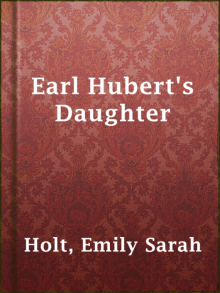


Earl Hubert's Daughter
Emily Sarah Holt

Produced by Nick Hodson of London, England
Earl Hubert's Daughter, by Emily Sarah Holt.
________________________________________________________________________This is one of Emily Holt's admirable and deeply researched historicalnovels, this time set in the early years of the thirteenth century. Themain players in the story appear at first sight to be the upper-classladies of the Court, and their various somewhat confusing relationships.
But early in the book an old Jewish pedlar comes and displays rich waresof a surprising value and variety. One of the girls asks if he can getsome special embroidery done on a scarf she wants to give as a present.Abraham sends in his young daughter Belasez and conditions are agreedsuch that she will not be called upon to do or eat anything she shouldnot, and all this seems to work very well. But the story involvingBelasez, her mother Licorice, and her brother Delecresse, gets more andmore involved and interesting. Belasez realises that there has beensomething in the past that she wants to unearth, and gradually the wholestrange story is revealed.
________________________________________________________________________EARL HUBERT'S DAUGHTER, BY EMILY SARAH HOLT.
PREFACE.
The thirteenth century was one of rapid and terrible incidents,tumultuous politics, and in religious matters of low and degradingsuperstition. Transubstantiation had just been formally adopted as adogma of the Church, accompanied as it always is by sacramentalconfession, and quickly followed by the elevation of the host and theinvention of the pix. Various Orders of monks were flocking intoEngland. The Pope was doing his best, aided by the Roman clergy, and totheir shame be it said, by some of the English, to fix his iron yoke onthe neck of the Church of England. The doctrine of human merit was atits highest pitch; the doctrine of justification by faith was absolutely_unknown_.
Amid this thick darkness, a very small number of true-hearted,Heaven-taught men bore aloft the torch of truth--that is, of so muchtruth as they knew. One of such men as these I have sketched in FatherBruno. And if, possibly, the portrait is slightly over-charged for thedate,--if he be represented as a shade more enlightened than at thattime he could well be--I trust that the anachronism will be pardoned forthe sake of those eternal verities which would otherwise have been leftwanting.
There is one fact in ecclesiastical history which should never beforgotten, and this is, that in all ages, within the visible corporatebody which men call the Church, God has had a Church of His own, true,living, and faithful. He has ever reserved to Himself that typicalseven thousand in Israel, of whom all the knees have not bowed untoBaal, and every mouth hath not kissed him.
Such men as these have been termed "Protestants before the Reformation."The only reason why they were not Protestants, was because there was asyet no Protestantism. The heavenly call to "come out of her" had notyet been heard. These men were to be found in all stations andcallings; on the throne--as in Alfred the Great, Saint Louis, and Henrythe Sixth; in the hierarchy--as in Anselm, Bradwardine, and Grosteste;in the cloister--as in Bernard de Morlaix; but perhaps most frequentlyin that rank and file of whom the world never hears, and of some ofwhom, however low their place in it, the world is not worthy.
These men often made terrible blunders--as Saint Louis did when hepersecuted the Jews, under the delusion that he was thus doing honour tothe Lord whom they had rejected: and Bernard de Morlaix, when he led acrusade against the Albigenses, of whom he had heard only slanderousreports. Do we make no blunders, that we should be in haste to judgethem? How much more has been given to us than to them! How much more,then, will be required?














